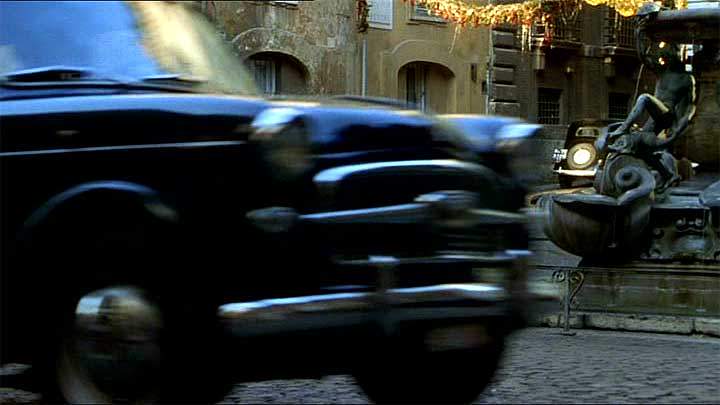The Talented Mr. Ripley 1999

In the idyllic Italian setting of the late 1950s, Tom Ripley becomes captivated by the privileged life of Dickie Greenleaf. Hired by Dickie's father to persuade him to return home, Ripley finds himself increasingly drawn to Dickie’s wealth and carefree existence. As Ripley becomes entangled in Dickie's world, he develops a dangerous obsession and will resort to extreme measures to obtain the lifestyle he desires.
Does The Talented Mr. Ripley have end credit scenes?
No!
The Talented Mr. Ripley does not have end credit scenes. You can leave when the credits roll.
Meet the Full Cast and Actors of The Talented Mr. Ripley
Explore the complete cast of The Talented Mr. Ripley, including both lead and supporting actors. Learn who plays each character, discover their past roles and achievements, and find out what makes this ensemble cast stand out in the world of film and television.
External Links and Streaming Options
Discover where to watch The Talented Mr. Ripley online, including streaming platforms, rental options, and official sources. Compare reviews, ratings, and in-depth movie information across sites like IMDb, TMDb, Wikipedia or Rotten Tomatoes.
Ratings and Reviews for The Talented Mr. Ripley
See how The Talented Mr. Ripley is rated across major platforms like IMDb, Metacritic, and TMDb. Compare audience scores and critic reviews to understand where The Talented Mr. Ripley stands among top-rated movies in its genre.

76
Metascore
7.2
User Score


%
TOMATOMETER

0%
User Score

7.4 /10
IMDb Rating

72
%
User Score
Take the Ultimate The Talented Mr. Ripley Movie Quiz
Challenge your knowledge of The Talented Mr. Ripley with this fun and interactive movie quiz. Test yourself on key plot points, iconic characters, hidden details, and memorable moments to see how well you really know the film.
The Talented Mr. Ripley Quiz: Test your knowledge on the intricate plot and characters of 'The Talented Mr. Ripley'.
What occupation does Tom Ripley initially hold in New York City?
restroom attendant
pianist
shipbuilder
detective
Show hint
Awards & Nominations for The Talented Mr. Ripley
Discover all the awards and nominations received by The Talented Mr. Ripley, from Oscars to film festival honors. Learn how The Talented Mr. Ripley and its cast and crew have been recognized by critics and the industry alike.
72nd Academy Awards 2000

Art Direction
Costume Design
Music (Original Score)

Writing (Screenplay Based on Material Previously Produced or Published)
Anthony Minghella53rd British Academy Film Awards 2000
Best Film




Best Cinematography
Best Original Music
5th Critics' Choice Awards 2000
Best Composer
57th Golden Globe Awards 2000
Best Motion Picture – Musical or Comedy


Best Supporting Performance in a Motion Picture – Drama, Musical or Comedy (Actor)
Jude Law
Best Original Score – Motion Picture
Full Plot Summary and Ending Explained for The Talented Mr. Ripley
Read the complete plot summary of The Talented Mr. Ripley, including all major events, twists, and the full ending explained in detail. Explore key characters, themes, hidden meanings, and everything you need to understand the story from beginning to end.
Tom Ripley, portrayed by Matt Damon, is a young man navigating the harsh realities of late 1950s New York City, where he relies on his dubious skills in forgery, deception, and impersonation to survive. His life takes an unexpected turn when, while working as a restroom attendant in a luxurious Manhattan hotel, he meets a Princeton graduate who offers him payment to fill in as a pianist at an alumni party, having just suffered a hand injury. Accepting the offer becomes a pivotal moment for Ripley.
During the cocktail party, Ripley is inadvertently approached by wealthy shipbuilder Herbert Greenleaf, played by James Rebhorn, who wrongly assumes Ripley attended Princeton with his son, Dickie. Mistakenly believing Ripley to be a classmate, Greenleaf hires him to travel to Italy and persuade Dickie to return to the U.S., promising Ripley $1,000 for his efforts. Without any prior knowledge of Dickie or Princeton, Ripley seizes the opportunity and embarks on a journey that will change his life forever.
Ripley’s modest life—a cramped two-room apartment in a decrepit area of New York—is soon revealed. His background is cloaked in mystery, suggested to have been marred by a tumultuous past where he was estranged from his family after coming out as gay. This sense of alienation fuels Ripley’s quest for companionship, and he seeks solace in the form of a romantic connection.
Upon arriving in Europe by ship, Ripley encounters the enchanting Meredith Logue, a cotton heiress portrayed by Cate Blanchett. Their brief but impactful conversation leads Ripley to impulsively masquerade as Dickie, later reflecting in a voice-over, “it is better to be a fake somebody than a real nobody.”
Once in Italy, Ripley skillfully engineers a fabricated encounter with Dickie, played by Jude Law, and his fiancée, Marge Sherwood, portrayed by Gwyneth Paltrow. He implies an intricate history of friendship that never existed, and although Dickie initially rejects the news of his father’s intentions, Ripley cleverly insinuates himself into Dickie’s life, further entangling himself in a web of deceit. Together, they devise a plan to extract more funds from Dickie’s father by suggesting Dickie’s indecision about coming home.
However, Ripley’s close presence soon becomes a source of irritation for Dickie, who begins to tire of Ripley’s incessant companionship. The situation escalates when Ripley takes Dickie on a final boating excursion. Following a climactic confrontation where Ripley, overwhelmed with jealousy and rage, inadvertently kills Dickie, he is left to grapple with the consequences of his actions.
In a desperate attempt to evade the authorities and maintain Dickie’s luxurious lifestyle, Ripley assumes Dickie’s identity, forging signatures, and manipulating communication with Marge to sustain the illusion that he is alive. This precarious existence is complicated further by the resurgent interest from Dickie’s friends and family, including a private detective hired to uncover the truth behind Dickie’s disappearance.
As Ripley bends his moral compass to survive, Marge grows suspicious, culminating in a dramatic encounter that involves deception and manipulation. Yet, as circumstances align, Ripley manages to escape scrutiny time and again—including evading the detective’s inquiries and deepening his relationship with Peter Smith-Kingsley.
The tension reaches its peak when Ripley finds himself aboard a cruise with both Peter and Meredith. Knowing that their acquaintance could jeopardize the carefully constructed facade he has maintained, Ripley struggles with the threat of exposure. Ultimately, in a haunting moment of desperation, he silences Peter forever, casting him overboard to safeguard his secret.
By the end of his tumultuous journey filled with greed, deceit, and tragic decisions, Tom Ripley, now unflinchingly aware that he remains free yet isolated, resigns himself to a solitary existence devoid of true love and acceptance, echoing the depths of his tragic character.
Uncover the Details: Timeline, Characters, Themes, and Beyond!

Coming soon on iOS and Android
The Plot Explained Mobile App
From blockbusters to hidden gems — dive into movie stories anytime, anywhere. Save your favorites, discover plots faster, and never miss a twist again.
Sign up to be the first to know when we launch. Your email stays private — always.
Watch Trailers, Clips & Behind-the-Scenes for The Talented Mr. Ripley
Watch official trailers, exclusive clips, cast interviews, and behind-the-scenes footage from The Talented Mr. Ripley. Dive deeper into the making of the film, its standout moments, and key production insights.
Cars Featured in The Talented Mr. Ripley
Explore all cars featured in The Talented Mr. Ripley, including their makes, models, scenes they appear in, and their significance to the plot. A must-read for car enthusiasts and movie buffs alike.
The Talented Mr. Ripley Themes and Keywords
Discover the central themes, ideas, and keywords that define the movie’s story, tone, and message. Analyze the film’s deeper meanings, genre influences, and recurring concepts.

Unlock the World of Movies with Our Comprehensive Wiki
Dive into our Movie Wiki for in-depth film encyclopedia entries, including cast biographies, production trivia, plot synopses, behind-the-scenes facts, and thematic analyses. Whether you’re researching iconic directors, exploring genre histories, or discovering hidden easter eggs, our expertly curated movie database has everything you need to fuel your cinematic passion.

Similar Movies To The Talented Mr. Ripley You Should Know About
Browse a curated list of movies similar in genre, tone, characters, or story structure. Discover new titles like the one you're watching, perfect for fans of related plots, vibes, or cinematic styles.
Quick Links: Summary, Cast, Ratings, More

What's After the Movie?
Not sure whether to stay after the credits? Find out!
Explore Our Movie Platform
New Movie Releases (2025)
Famous Movie Actors
Top Film Production Studios
Movie Plot Summaries & Endings
Major Movie Awards & Winners
Best Concert Films & Music Documentaries
Movie Collections and Curated Lists
© 2025 What's After the Movie. All rights reserved.









































